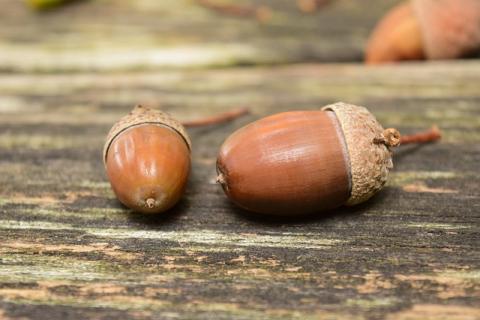
There is a myth surrounding acorns that states Acorns are poisonous and can’t be eaten! Acorns can be eaten, but you wouldn’t want to just pick one up and eat it. There’s a leaching process that must be done in order to make the acorns edible.
Depending on your location, acorns typically start falling off of the oak trees starting as early as September and continuing through early spring, depending on the variety. Acorns are full of starch, which means they are full of carbohydrates: a food forager’s dream. Acorns are also full of tannins, which taste very unpleasant and quite astringent – that’s why the leaching process is necessary. There are several different methods to leaching, and today I will tell you about two I have used personally.
All oak trees produce acorns. Some oak trees produce more tannins than others so the trick is knowing your trees, your nuts, and how to tell the difference. Red oak trees typically contain more tannins than white oak species. I have heard that the Emory oak tree produces acorns with almost no tannins. When acorns are leached properly they have a nutty, somewhat sweet, flavor about them. If much is consumed, tannins will cause upset stomachs and other stomach issues, including diarrhea. Always leach acorns first.
So all you have to do is pay attention to when the acorns start falling, and then go out and harvest them as quickly as possible to avoid any bugs making homes inside the nut. Once you’ve harvested your bounty you can do a float test to check for holes in the acorns: if the acorn floats, that indicates holes, holes mean bugs and unless you are into eating bugs for protein (by the way, the weevils that make homes in acorns are edible – just sayin’), you’ll want to return floating acorns outside.
Leeching Acorns
The cold water leaching process is believed to preserve the starches from the acorns, whereas boiling the acorns will destroy the starches. Whether you’ll want to preserve the starches will depend on your preference, though the starch is essentially the “energy” in this food.
Cold Water Leaching
First, shell your acorns. You can do this by cutting open the shell and removing the acorn. Or you can dry them out over the fire, making the shells brittle enough to crack.
Once the acorns are shelled, run them through a grain grinder. You’ll want the acorn flour as coarse as possible.
Cover the acorn flour with cold water. When all of the acorn grit settles at the bottom of the bowl, switch out the water. Using a cheesecloth to strain the flour, place it back in the bowl and fill it back up with water.
Repeat this process 3-4 times a day for a few days. You can occasionally taste a little bit of the flour; once the acidic astringent taste is gone, the leaching process is complete. If the astringent taste is still strong, continue the process until it is palatable.
Strain the acorn flour one last time through the cheesecloth and spread it out in a baking pan or something similar. You can set it to air dry in the sun, occasionally stirring and mixing it to ensure it dries out evenly. Or you can let it dry out over the fire.
Hot Water Leaching
This process will destroy the starches but speed up the process. Simply shell the acorns and pound them into small pieces.
Over a fire boil the acorns in a kettle pot. Every 45 minutes to an hour the water has to be dumped out and switched with fresh clean water. Do this for about 5-7 hours or until the acorns are edible to the palate.
If you want to try acorn flour before you go through the trouble of the leaching process, you can purchase it from health food stores and through various online stores. I love making apple cinnamon acorn cakes on the griddle.








